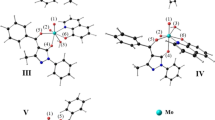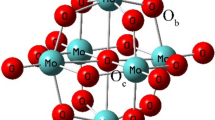Abstract
Oxidovanadium(IV) complexes have revealed interesting pharmacological properties which make them promising agents in the treatment of diabetes mellitus. A computational study of 17 complexes of oxidovanadium(IV) with 3-hydroxy-4-pyrone- and 3-hydroxy-4-pyridinone-based ligands was carried out at the density functional theory level. The geometry, electronic structure, and vibration modes at the metallic center were predicted, and their dependence on the nature of the ligand was evaluated. Slight distinctions between both classes of compounds were observed, namely the higher value of dipole moments and the smaller HOMO–LUMO energy gap for the 3-hydroxy-4-pyridinone-based complexes. The modes of vibration at the metallic coordination region do not vary significantly throughout the whole series, and a particular corrective scaling factor is proposed for the V=O stretching mode of this type of oxidovanadium(IV) complexes. The results presented here are of particular relevance since it was not yet possible to obtain X-ray diffraction data for the oxidovanadium(IV) complexes of 3-hydroxy-4-pyridinones, and also as the influence of the solvent, in particular the local interaction at the sixth coordination position, was considered.




Similar content being viewed by others
References
Yeh GY, Eisenberg DM, Kaptchuck TJ, Phillips RS (2003) Diabetes Care 26:1277–1294
Sakurai H, Yasui H, Adachi Y (2003) Expert Opin Investig Drugs 12:1189–1203
Thompson KH, Orvig C (2001) Coord Chem Rev 1033:219–221
Shechter Y, Goldwaser I, Mironchik M, Fridkin M, Gefel D (2003) Coord Chem Rev 237:3–11
Saha TK, Yoshikawa Y, Yasui H, Sakurai H (2006) Bull Chem Soc Jpn 79:1191–1200
Zborowski K, Grybos R, Proniewicz M (2005) Inorg Chem Commun 8:76–78
Rangel M, Amorim MJ, Nunes A, Leite A, Pereira E, de Castro B, Sousa C, Yoshikawa Y, Sakuri H (2009) J Inorg Biochem 103:496–502
Rangel M, Leite A, Amorim MJ, Garriba E, Micera G, Lodyga-Chruscinska E (2006) Inorg Chem 45:8086–8097
Burgess J, de Castro B, Oliveira C, Rangel M, Schlindwein W (1997) Polyhedron 16:789–794
Caravan P, Gelmini L, Glover N, Herring GF, Li H, McNeill JH, Rettig SJ, Setyawati IA, Shuter E, Sun Y, Tracey AS, Yuen VG, Orvig C (1995) J Am Chem Soc 117:12759–12770
Cramer CJ, Truhlar DG (2009) Phys Chem Chem Phys 11:10757–10816
Becke AD (1993) J Chem Phys 98:5648–5652
Becke AD (1988) Phys Rev 38:3098–3100
Lee C, Yang W, Parr RG (1988) Phys Rev B 37:785–789
Stevens PJ, Devlin FJ, Chabalowski CF, Frisch MJ (1994) J Chem Phys 98:11623–11627
Frisch MJ, Trucks GW, Schlegel HB, Scuseria GE, Robb MA, Cheeseman JR, Montgomery Jr JA, Vreven T, Kudin KN, Burant JC, Millam JM, Iyengar SS, Tomasi J, Barone V, Mennucci B, Cossi M, Scalmani G, Rega N, Petersson GA, Nakatsuji H, Hada M, Ehara M, Toyota K, Fukuda R, Hasegawa J, Ishida M, Nakajima T, Honda Y, Kitao O, Nakai H, Klene M, Li X, Knox JE, Hratchian HP, Cross JB, Bakken V, Adamo C, Jaramillo J, Gomperts R, Stratmann RE, Yazyev O, Austin AJ, Cammi R, Pomelli C, Ochterski JW, Ayala PY, Morokuma K, Voth GA, Salvador P, Dannenberg JJ, Zakrzewski VG, Dapprich S, Daniels AD, Strain MC, Farkas O, Malick DK, Rabuck AD, Raghavachari K, Foresman JB, Ortiz JV, Cui Q, Baboul AG, Clifford S, Cioslowski J, Stefanov BB, Liu G, Liashenko A, Piskorz P, Komaromi I, Martin RL, Fox DJ, Keith T, Al-Laham MA, Peng CY, Nanayakkara A, Challacombe M, Gill PMW, Johnson B, Chen W, Wong MW, Gonzalez C, Pople JA (2004) Gaussian 03, revision C.02. Gaussian Inc., Wallingford, CT
Schaftenaar G, Noordik JH (2000) J Comput Aided Mol Des 14:123–134
Flükiger P, Lüthi HP, Portmann S, Weber J (2003) MOLEKEL 4.3: Molecular Visualization Software, Swiss Center for Scientific Computing, Manno
Mennucci B, Cancès E, Tomasi J (1997) J Phys Chem B 101:10506–10517
Mennucci B, Cammi R, Tomasi J (1998) J Chem Phys 109:2798–2807
Mennucci B, Cammi R, Tomasi J (1999) J Chem Phys 110:6858–6870
Barone V, Cossi M, Tomassi J (1997) J Chem Phys 107:3210–3221
Chong DP, Gritsenko OV, Baerends EJ (2002) J Chem Phys 116:1760–1772
Stowasser R, Hoffman R (1999) J Am Chem Soc 121:3414–3420
Pearson RG (1986) Proc Natl Acad Sci USA 83:8440–8441
Jarrais B, Pereira C, Silva AR, Carvalho AP, Pires J, Freire C (2009) Polyhedron 28:994–1000
Yuen VG, Caravan P, Gelmini L, Glover N, McNeill JH, Setyawati IA, Zhou Y, Orvig C (1997) J Inorg Biochem 68:109–116
Magalhães AL, Soares Pinto AS (2003) Theor Chem Acc 110:70–78
Author information
Authors and Affiliations
Corresponding authors
Electronic supplementary material
Below is the link to the electronic supplementary material.
Rights and permissions
About this article
Cite this article
Biernacki, K., Magalhães, A.L., Freire, C. et al. A DFT quantum mechanical study of 3-hydroxy-4-pyrone and 3-hydroxy-4-pyridinone based oxidovanadium(IV) complexes. Struct Chem 22, 697–706 (2011). https://doi.org/10.1007/s11224-011-9748-5
Received:
Accepted:
Published:
Issue Date:
DOI: https://doi.org/10.1007/s11224-011-9748-5




